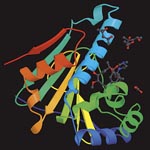Structure of the first mammalian GRP94 protein solved

Washington, October 13 : A senior researcher at the Hauptman-Woodward Medical Research Institute (HWI) has for the first time solved the structure of the mammalian GRP94 protein, implicated in immune diseases such as sepsis, AIDS, and certain cancers.
Dr. Dan Gewirth says that his study confirms his own 2001 hypothesis that this protein belongs to the same family as the better-known HSP90 proteins, which are key players in cellular regulation and recognition.
Nowadays, scientists are working on inhibitors of HSP90s, which may offer therapies for diseases ranging from cancer to sepsis. It is believed that drugs that stimulate HSP90 action may be appropriate therapies for diseases that involve protein folding such as cystic fibrosis, prion diseases, and Alzheimer’s disease.
Dr. Gewirth has been using the X-ray diffraction technique to solve the first high-resolution structure of this protein from mammalian origins since 2001.
His aim was to understand the GRP94 protein’s function and to determine whether it is a member of the HSP90 family of proteins, which he says has been affirmed by the structure and activity patterns of the protein.
“Our work opens the door to a more intensive evaluation of this protein both from a mechanistic as well as a therapeutic point of view. In addition to aiding our understanding of the fundamental biology of chaperone-mediated protein folding, this work lays the foundation for the design of drugs that specifically target individual members of the hsp90 family” Gewirth, who also holds a post as an associate professor in the Structural Biology department of the University at Buffalo which is housed at the Hauptman-Woodward Medical Research Institute, said.
Writing about the importance of his study in the journal Molecular Cell, Dr. Gewirth said that his work showed for the first time how members of the HSP 90 family of chaperone proteins can differ from each other, while still being part of the same overall family.
He revealed that the mammalian member of the protein family was different from the ones previously studied, which were solved from either bacteria or yeast. According to him, human energy production and consumption rates are more similar to those found in the GRP94 proteins than to the more widely studied HSP90 proteins.
The researcher says that inhibitors being made these days are designed for HSP90 in an attempt to treat the diseases in which HSP90 plays a role, but being broad-spectrum inhibitors of all HSP90s, they may cause unwanted side effects.
Dr. Gewirth claims that his study has already clarified GRP94’s place in this family, and stimulated interest in this chaperone as a drug target. According to him, this understanding may allow for the long-term development of a family of drugs that could be narrowly targeted for individual proteins, for instance specifically treating sepsis only.
“This will spur a new line of inquiry into GRP94. While this work is its infancy, medicinal chemists will be interested in developing GRP94-targeted drugs,” he said. (ANI)